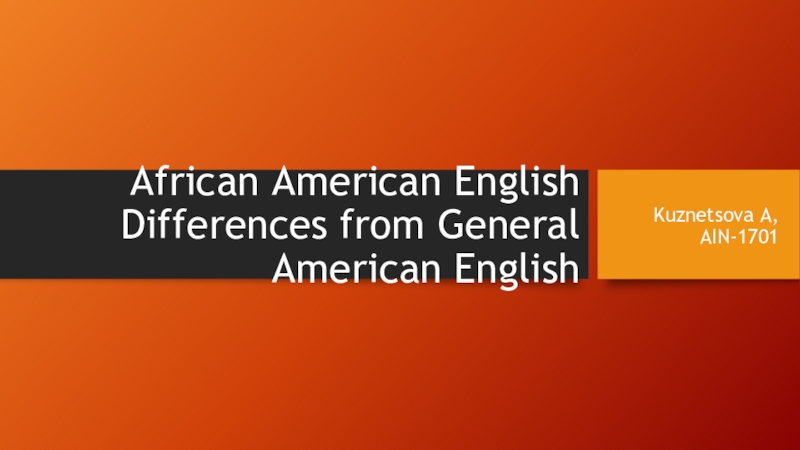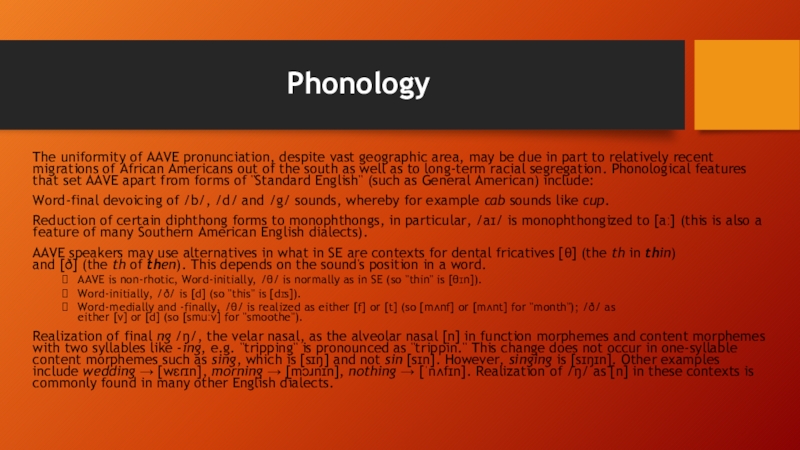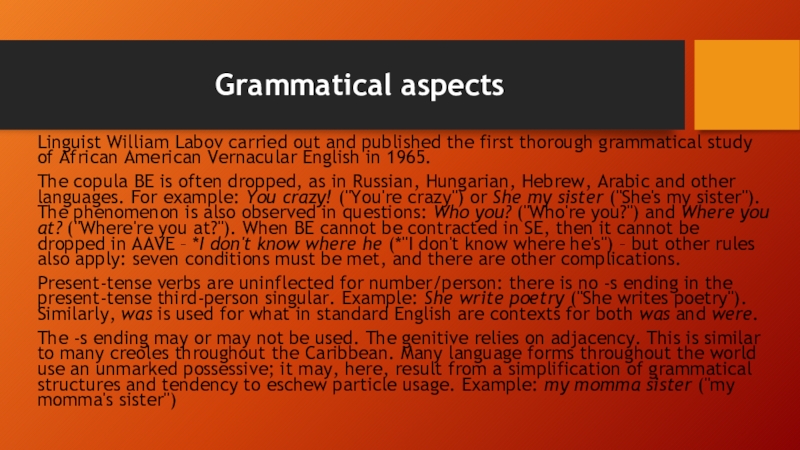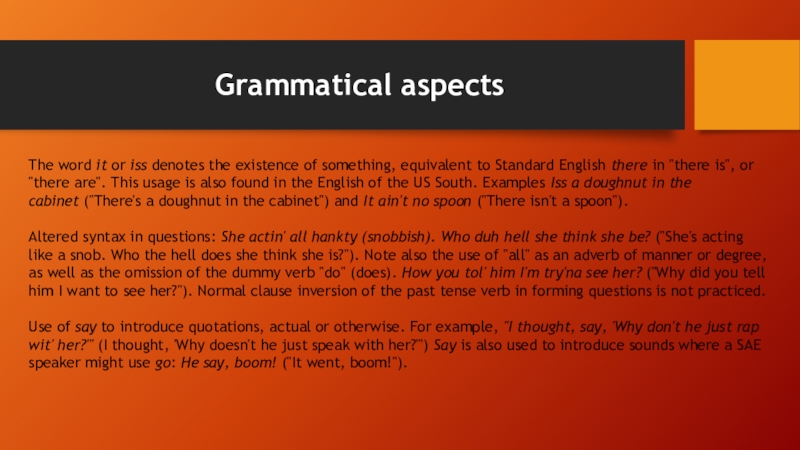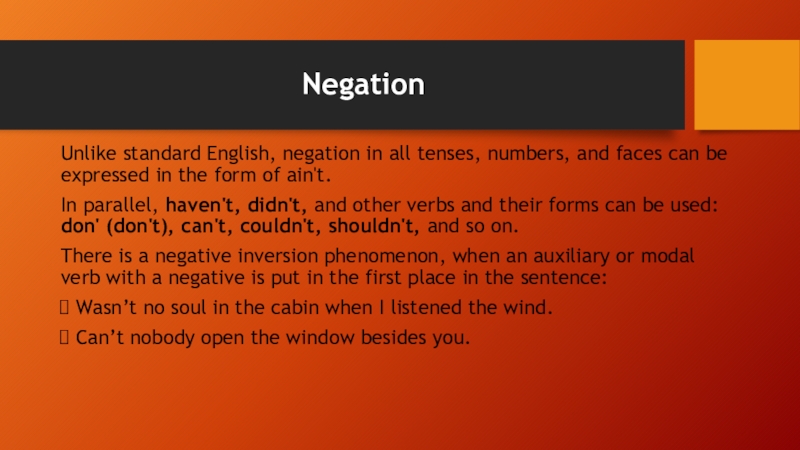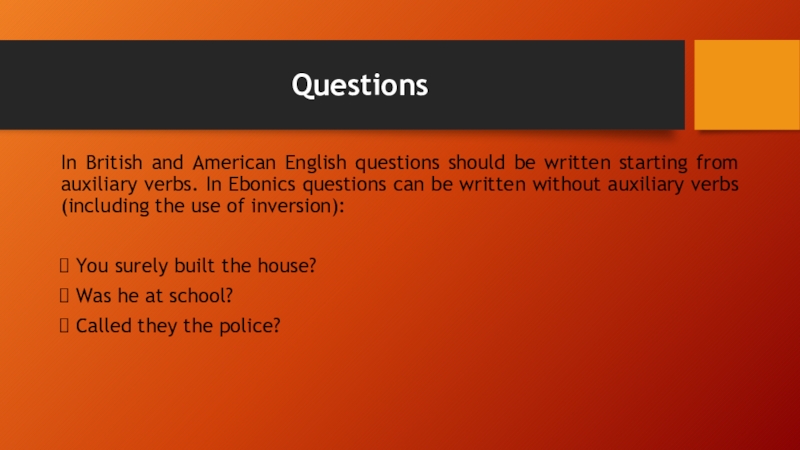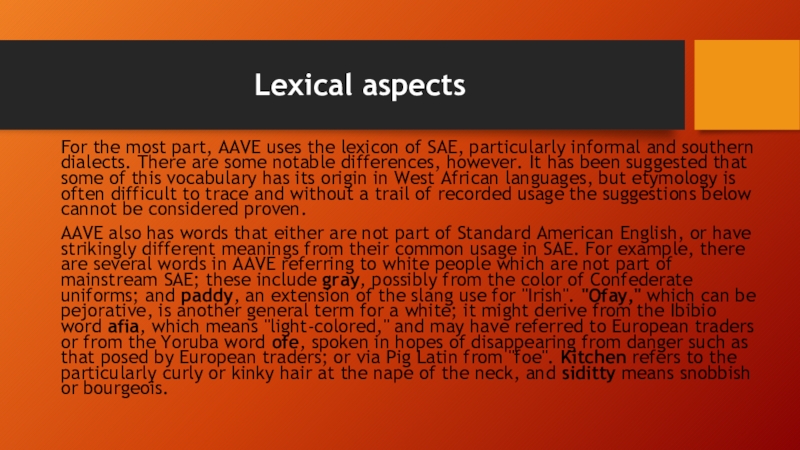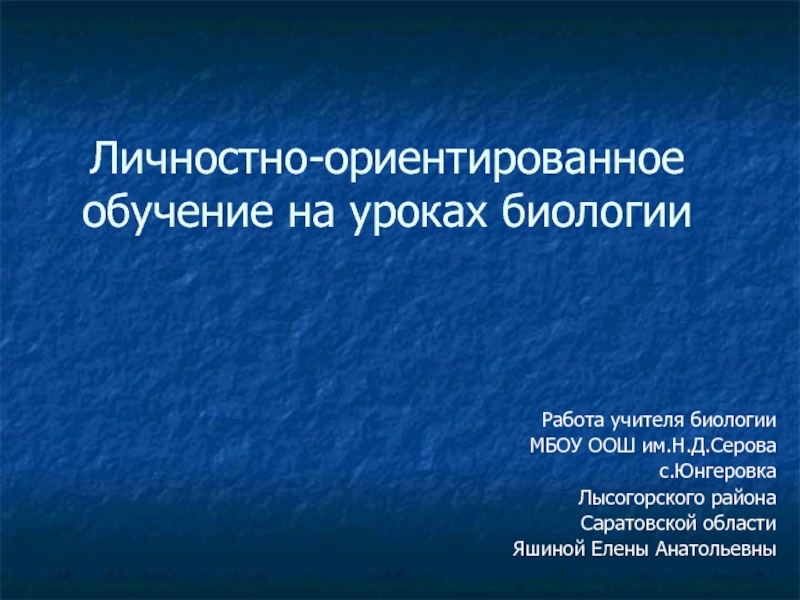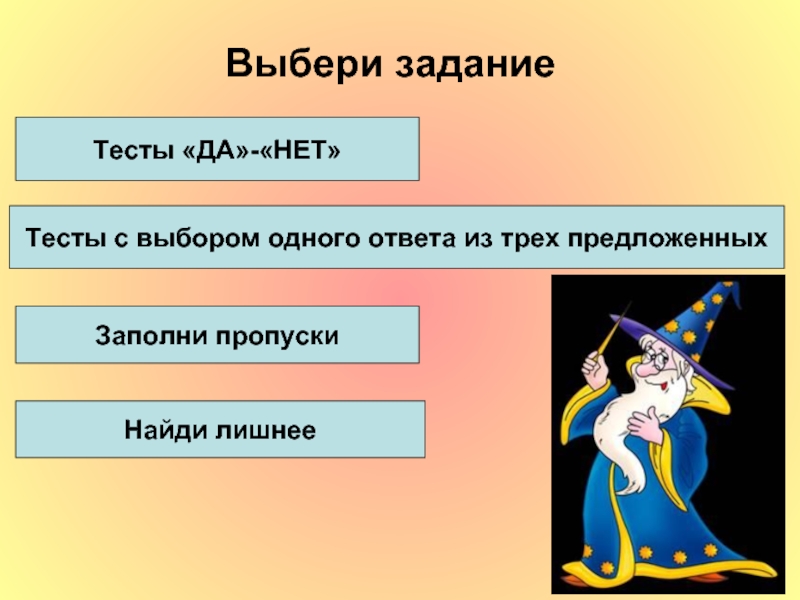Разделы презентаций
- Разное
- Английский язык
- Астрономия
- Алгебра
- Биология
- География
- Геометрия
- Детские презентации
- Информатика
- История
- Литература
- Математика
- Медицина
- Менеджмент
- Музыка
- МХК
- Немецкий язык
- ОБЖ
- Обществознание
- Окружающий мир
- Педагогика
- Русский язык
- Технология
- Физика
- Философия
- Химия
- Шаблоны, картинки для презентаций
- Экология
- Экономика
- Юриспруденция
African American English Differences from General American English
Содержание
- 1. African American English Differences from General American English
- 2. African-American English (AAE), also known as Black
- 3. About "80 to 90 percent of American
- 4. PhonologyThe uniformity of AAVE pronunciation, despite vast
- 5. Phonology/l/ is often deleted after a vowel and,
- 6. Grammatical aspectsLinguist William Labov carried out and
- 7. The word it or iss denotes the existence of something, equivalent
- 8. NegationUnlike standard English, negation in all tenses,
- 9. QuestionsIn British and American English questions should
- 10. Lexical aspectsFor the most part, AAVE uses
- 11. Exampleshttps://youtu.be/dI38GtWFihYhttps://youtu.be/rNjhB1DW_-s
- 12. Скачать презентанцию
African-American English (AAE), also known as Black English in American linguistics, is the set of English dialects primarily spoken by most black people in the United States and many in Canada;
Слайды и текст этой презентации
Слайд 3About "80 to 90 percent of American blacks” speak AAVE
“at least some of the time". Additionally, AAVE shares many characteristics
with various Creole English dialects spoken by black people throughout much of the world. AAVE also has pronunciation, grammatical structures, and vocabulary in common with various West African languages (Trudgill).The pronunciation of AAVE is based in large part on Southern American English, an influence that no doubt was reciprocal in many ways. The traits of AAVE that separate it from Standard American English (SAE) include:
changes in pronunciation along definable patterns, many of which are found in creoles and dialects of other populations of West African descent (but which also emerge in English dialects uninfluenced by West African languages, such as Newfoundland English);
distinctive vocabulary; and
differences in the use of tenses.
AAVE also has contributed to Standard American English words of African origin ("gumbo", "goober", "yam", "banjo") and slang expressions ("cool," "hip," "hep cat" "bling"). In areas of close socialization between speakers of AAVE and other groups of people, a greater number of non-black speakers exist.
Слайд 4Phonology
The uniformity of AAVE pronunciation, despite vast geographic area, may
be due in part to relatively recent migrations of African
Americans out of the south as well as to long-term racial segregation. Phonological features that set AAVE apart from forms of "Standard English" (such as General American) include:Word-final devoicing of /b/, /d/ and /g/ sounds, whereby for example cab sounds like cup.
Reduction of certain diphthong forms to monophthongs, in particular, /aɪ/ is monophthongized to [aː] (this is also a feature of many Southern American English dialects).
AAVE speakers may use alternatives in what in SE are contexts for dental fricatives [θ] (the th in thin) and [ð] (the th of then). This depends on the sound's position in a word.
AAVE is non-rhotic, Word-initially, /θ/ is normally as in SE (so "thin" is [θɪn]).
Word-initially, /ð/ is [d] (so "this" is [dɪs]).
Word-medially and -finally, /θ/ is realized as either [f] or [t] (so [mʌnf] or [mʌnt] for "month"); /ð/ as either [v] or [d] (so [smuːv] for "smoothe").
Realization of final ng /ŋ/, the velar nasal, as the alveolar nasal [n] in function morphemes and content morphemes with two syllables like -ing, e.g. "tripping" is pronounced as "trippin." This change does not occur in one-syllable content morphemes such as sing, which is [sɪŋ] and not sin [sɪn]. However, singing is [sɪŋɪn]. Other examples include wedding → [wɛɾɪn], morning → [mɔɹnɪn], nothing → [ˈnʌfɪn]. Realization of /ŋ/ as [n] in these contexts is commonly found in many other English dialects.
Слайд 5Phonology
/l/ is often deleted after a vowel and, in combination with
the above feature, can make bold, bowl, and bow homophones.
Before nasal consonants (/m/, /n/, and /ŋ/), /ɛ/ and /ɪ/ are
both pronounced as [ɪ], making pen and pin homophones.Before /l/, /ɪ/ and /iː/ are pronounced as /ɪ/, making feel and fill homophones.
After a vowel, a nasal may be lost while nasalization of the vowel is retained. E.g, find may be pronounced [fã].
Dropping of word initial /d/, /b/, and /g/ in tense-aspect markers, e.g., the pronunciation of don't like own.
Lowering of /ɪ/ to /ɛ/ or /æ/ before /ŋ/ causing pronunciations such as [tɛŋ] or [tæŋ] for thing.
Use of metathesised forms like "aks" for "ask“ or "graps" for "grasp." Both these examples existed in Anglo-Saxon and more recent varieties of English, and may be survivals of non-standard forms.
Слайд 6Grammatical aspects
Linguist William Labov carried out and published the first
thorough grammatical study of African American Vernacular English in 1965.
The
copula BE is often dropped, as in Russian, Hungarian, Hebrew, Arabic and other languages. For example: You crazy! ("You're crazy") or She my sister ("She's my sister"). The phenomenon is also observed in questions: Who you? ("Who're you?") and Where you at? ("Where're you at?"). When BE cannot be contracted in SE, then it cannot be dropped in AAVE – *I don't know where he (*"I don't know where he's") – but other rules also apply: seven conditions must be met, and there are other complications.Present-tense verbs are uninflected for number/person: there is no -s ending in the present-tense third-person singular. Example: She write poetry ("She writes poetry"). Similarly, was is used for what in standard English are contexts for both was and were.
The -s ending may or may not be used. The genitive relies on adjacency. This is similar to many creoles throughout the Caribbean. Many language forms throughout the world use an unmarked possessive; it may, here, result from a simplification of grammatical structures and tendency to eschew particle usage. Example: my momma sister ("my momma's sister")
Слайд 7The word it or iss denotes the existence of something, equivalent to Standard English there in
"there is", or "there are". This usage is also found
in the English of the US South. Examples Iss a doughnut in the cabinet ("There's a doughnut in the cabinet") and It ain't no spoon ("There isn't a spoon").Altered syntax in questions: She actin' all hankty (snobbish). Who duh hell she think she be? ("She's acting like a snob. Who the hell does she think she is?"). Note also the use of "all" as an adverb of manner or degree, as well as the omission of the dummy verb "do" (does). How you tol' him I'm try'na see her? ("Why did you tell him I want to see her?"). Normal clause inversion of the past tense verb in forming questions is not practiced.
Use of say to introduce quotations, actual or otherwise. For example, "I thought, say, 'Why don't he just rap wit' her?'" (I thought, 'Why doesn't he just speak with her?'") Say is also used to introduce sounds where a SAE speaker might use go: He say, boom! ("It went, boom!").
Grammatical aspects
Слайд 8Negation
Unlike standard English, negation in all tenses, numbers, and faces
can be expressed in the form of ain't.
In parallel, haven't,
didn't, and other verbs and their forms can be used: don' (don't), can't, couldn't, shouldn't, and so on.There is a negative inversion phenomenon, when an auxiliary or modal verb with a negative is put in the first place in the sentence:
Wasn’t no soul in the cabin when I listened the wind.
Can’t nobody open the window besides you.
Слайд 9Questions
In British and American English questions should be written starting
from auxiliary verbs. In Ebonics questions can be written without
auxiliary verbs (including the use of inversion):You surely built the house?
Was he at school?
Called they the police?
Слайд 10Lexical aspects
For the most part, AAVE uses the lexicon of
SAE, particularly informal and southern dialects. There are some notable
differences, however. It has been suggested that some of this vocabulary has its origin in West African languages, but etymology is often difficult to trace and without a trail of recorded usage the suggestions below cannot be considered proven.AAVE also has words that either are not part of Standard American English, or have strikingly different meanings from their common usage in SAE. For example, there are several words in AAVE referring to white people which are not part of mainstream SAE; these include gray, possibly from the color of Confederate uniforms; and paddy, an extension of the slang use for "Irish". "Ofay," which can be pejorative, is another general term for a white; it might derive from the Ibibio word afia, which means "light-colored," and may have referred to European traders or from the Yoruba word ofe, spoken in hopes of disappearing from danger such as that posed by European traders; or via Pig Latin from "foe". Kitchen refers to the particularly curly or kinky hair at the nape of the neck, and siditty means snobbish or bourgeois.
